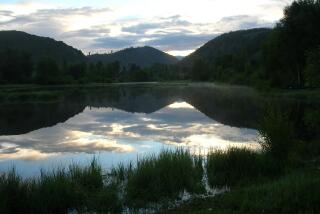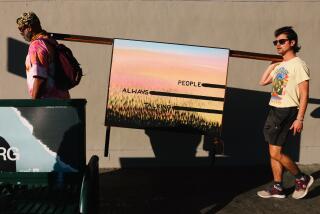Ojai Rancher Has a Different View of Origin of Man : Anthropology: The idea that humankind came from the New World--not Africa--is gaining credence, thanks to Alvah (Pardner) Hicks.
- Share via
Alvah (Pardner) Hicks of Ojai was only 22 when he bought his own piece of the mountain, a majestic 100-acre ranch inside Los Padres National Forest. Before he was 30, he was renowned as a trail guide, leading city slickers into the dark regions of the wilderness.
But in 1986, at the age of 31, Hicks abruptly sold his pack horses and quit the guide business. Transforming himself from outdoorsman to indoorsman, Hicks declared himself an anthropologist, hung out in libraries and became infatuated with the past.
The focus of his interest was the American Indian. Turning his ranch into an Indian cultural center complete with ceremonial sweat lodge, Hicks embarked on an anthropological journey into unchartered territory.
And, despite academic credentials ranging from slim to none, he had the audacity to champion the seemingly absurd theory that humans originated in the New World.
It was contrary to the universally accepted theory that man evolved in Africa, developed in Europe and arrived in the Americas 11,500 years ago by walking from Asia to North America across a land bridge. Hicks believes the migration took place--but in reverse.
“My theory is the anthropological equivalent of the Earth Is Flat Theory,” Hicks said. “Some people think I’m coming out of left field.”
But today, with recent archeological discoveries putting humans in the New World as early as 30,000 years ago, Hicks says the theory is gaining momentum.
Now a kind of anthropological gadfly, Hicks, 38, is making appearances at scientific symposiums, getting articles published in journals and hobnobbing with leaders in the fields of anthropology, archeology, linguistics and genetics.
“He’s really knowledgeable and I’m impressed by how easily he can get the top experts on the phone,” said Hal Fleming, professor emeritus of anthropology at Boston University who said he relies on Hicks “to give me the latest word on physical anthropology.”
According to Fleming, Hicks is “not the only one who believes the Americas were the source for at least the Indians and maybe all of mankind. It’s less likely than other theories but it’s not baloney.”
While Hicks has acquired a measure of grudging respect from academia, no one is prepared to anoint him as the next Charles Darwin. To most of the scientific community, Hicks is barking up the wrong evolutionary tree.
“He’s not a crackpot exactly, but his basic premise has no factual basis,” said Phillip Walker, professor of anthropology at UC Santa Barbara. “All substantial fossil evidence linking modern humans with early humans and non-human primates comes from the Old World.”
The notion that humans originated in the Americas--the plains of Argentina, to be specific--first surfaced at the turn of the century but was dismissed by Eurocentric scientists, said Hicks, who called their opposition “dogmatic rejection.”
Raised on a 400-acre cattle ranch in Ojai, Hicks became fixated on the theory while a student at Ojai Valley School in the early 1970s, but he was less interested then in creation than in recreation.
With hiking and camping a part of the curriculum at the school, Hicks got hooked on the outdoors, routinely taking 50-mile backpacking trips into the rugged national forest above Ojai.
Hicks bought his ranch in 1977. High on a mesa and ringed by mountains, the ranch is off California 33 near Pine Mountain about 45 minutes by car from Ojai. It was originally part of a 160-acre homestead costing 10 cents an acre in 1918. Hicks spent just under $1,000 an acre, using as his down payment some of the money his father had left him.
Hicks took an occasional night class at Ventura College and Pepperdine University but never got a degree, preferring to concentrate on his ranch, which he named Chorro Grande.
“I was more focused on self-sufficiency than a career,” he said.
Hicks usually had about a dozen friends living with him, but even though the ranch often served as a woodsy party retreat, it mainly provided a back-to-the-earth experience in which everybody lived off the land, growing vegetables and raising goats for milk and cheese. Bull sessions were often serious and scholarly.
“We were all interested in cultural things,” Hicks said.
In 1980, Hicks started the Chorro Grande Pack Station, taking six to eight riders on one-day or overnight excursions. He provided four-legged transportation and a tri-tip dinner over a blazing fire. Of the hundreds of greenhorns he escorted into the rugged back country, he never lost one, although Hicks did his best to inject a little Wild West excitement into their trips.
“I enjoyed going down the wrong trail and seeing their reaction when I told them we were lost,” Hicks said.
Being intimately connected with the national forest, Hicks and fellow trail guide Tony Alvis of La Conchita became involved in the federal government’s efforts to launch a condor recovery program in the Sespe Wilderness.
But they and others believed that a condor sanctuary in Ventura County was too close to civilization and pushed for an alternative in Santa Barbara County.
In 1986, Hicks and Alvis guided eight federal and environmental officials to Lion Canyon in the San Rafael Wilderness. The trip failed to change anybody’s mind and the first eight condors were released into the Sespe sanctuary beginning in January, 1992.
Today, however, only five condors are still alive, with three having been killed by man-made hazards. Ironically, the next condor release will take place in Lion Canyon. Missing a chance to say “I told you so,” Hicks simply said, “I doubt they’ll have the kinds of problems there as in the Sespe.”
In 1987, Hicks decided to go searching for the origins of man after a friend made a casual remark.
“He said we were all a bunch of Neanderthals,” Hicks said. Neanderthals, whose presence in the New World has not been found, are believed to have been replaced in Europe by Cro-Magnon man, the first fully evolved representative of Homo sapiens. Hicks couldn’t agree with his friend without compromising his own theory.
“I bet him $20 he was wrong,” Hicks said.
Lanny Kaufer, editor of Hicks’ scientific papers, has known him for about 20 years and was not surprised by his decision to chase anthropological rainbows.
“He’s always had a sharp intellectual mind,” said Kaufer, 46. “Years ago, I’d go see him at the ranch and he’d be sitting by a kerosene lamp reading a very technical book on astronomy.”
It was only natural that Hicks’ passion for anthropology led him to an interest in American Indians. In 1987, Hicks let an Ojibwa Indian named Ken Littlefish build a sweat lodge at Chorro Grande. Today, the ranch has become an Indian retreat and Hicks has immersed himself in Indian culture. He and Kaufer plan to start a nonprofit corporation to help modern Indians recapture their ancient traditions.
“The indigenous people of this continent are attempting to recover their old ways that had been taken away from them by relocation or removal,” Hicks said. “We hope to get enough financial resources to improve the land and begin to mirror the Indian way of life.”
Hicks wants to replace trailers at the ranch with Algonquian long houses and Chumash wickiups, small huts made of bent willow. He sees the ranch becoming a learning center teaching Indian lifestyles and their respect for nature.
The sweat lodge is at the spiritual core of Indian life. Earlier this month, Hicks was one of several people who took part in the time-honored purification ritual, which mixes mystic symbolism, prayer, song and group therapy.
Amid the beating of drums and the shaking of rattles, Hicks and the others disappeared into a squat, blanket-covered hut. Seven steaming-hot rocks were placed inside with them, enveloping the claustrophobic chamber with scalding vapor.
Two hours later, they emerged, muddy, exhausted but exhilarated. “It’s difficult to bear being so hot,” Hicks said. “But it tests one’s character.”
With all his big notions, the hot seat is nothing new to Hicks.
“I’m not somebody,” he said, “who believes in not being ambitious.”
More to Read
Sign up for Essential California
The most important California stories and recommendations in your inbox every morning.
You may occasionally receive promotional content from the Los Angeles Times.













